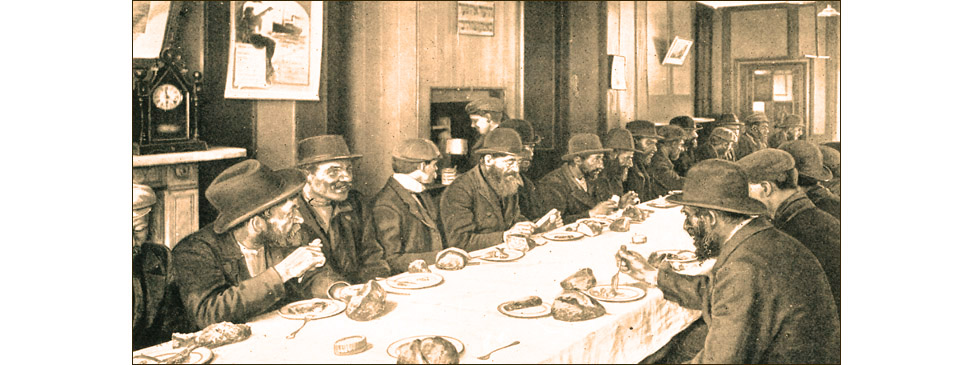London’s Jewish Community in the 19th century. Part 2 – Their lives

Newly-arrived men are provided with a frugal meal at the Poor Jew’s Temporary Shelter in around 1885. It began in Church Lane, Whitechapel. Sir Samuel Montagu and others took it over and provided a building in Leman Street to give a home for new arrivals for up to two weeks. It eventually sheltered up to 4,000 immigrants each year.
< Back to London’s Jewish community in the 19th century. Part 1 – Their arrival
There had been a small population of Sephardic Jews in London since the 17th century but persecution and massacres in Russia and Poland in the 19th century brought waves of poverty-stricken Ashkenazi Jewish refugees to London. Many toiled long hours in small East End workshops to earn the lowest wage at which life could be sustained. These alien people, who only mixed with their own and spoke in a strange tongue, with strange habits, struck the native English population as furtive and sinister.
Jews are townspeople, not farmers, and rarely lived in the countryside. In whichever towns the settled they clustered together, for self-protection, for reasons of language and culture, and to be within walking-distance of a synagogue. In the late 19th century and first half of the 20th century London’s main Jewish Quarter was in the Whitechapel, Spitalfields, and Mile End Old Town districts, and the parish of St. George-in-the-East. They were areas that had previously been settled by earlier Huguenot and German immigrants. The former people had largely assimilated and moved elsewhere but the less affluent German community remained in Whitechapel and St. George’s until the First World War. Towards the end of the 19th century 90% of the capital’s Jews lived in East London and 40% of the population of the Borough of Stepney were Jewish. The East End took on an exotic character: streets filled with people speaking Yiddish, Lettish (from Latvia) or German; men dressed in black jupizes (long coats) and with side-curls; Germanic names and Hebrew lettering over the shopfronts; kosher butchers; Jewish booksellers; and Jewish music-halls.
The East End area of two square miles was one of the most densely populated in the whole of England. Throughout the second half of the 19th century railway companies ran lines through East London, razing many homes along the way. Residents simply moved a few streets away, creating increased overcrowding as the number of houses decreased and the population grew with new arrivals. There were some streets of fine houses, albeit run-down, as well as mean slums, small, stinking alleyways and narrow courtyards. As with London’s other rookeries, water supply and sanitary conditions were often poor, which only began to improve when a new water authority was created after 1903. Refuse was often left to rot. Conditions inside many homes were bad, with leaking ceilings, damp walls, and foul water closets. In 1884 The Lancet published a report that galvanised the Jewish Board of Guardians into appointing an inspector of housing. Of those properties initially checked 93% were found to not have flushing toilets. Jews, tended to crowd more people into each dwelling, encouraging landlords, often themselves Jews, to charge higher rents than to Gentiles. The latter were then forced out of properties and whole streets became part of the Jewish ghetto. Many Jewish families took in lodgers, perhaps someone newly-arrived. Overcrowded homes were the norm, often with eight or nine people sharing two small rooms, and many doubled-up as workshops. Hence, much of home life was spent outside on the doorstep or in the street.
From the 1870s London’s slums were gradually cleared to make way for social housing. In 1884 the United Synagogue reported on the state of East End housing. This resulted in two private social housing companies. The Four Per Cent Industrial Dwellings Company, providing a four percent return to investors, was founded and chaired by Nathan Rothschild. (It still exists as the Industrial Dwellings Society). Samuel Barnett of the St. Jude’s church at Whitechapel was the primary instigator of the East End Dwellings Company.
There were two main groups of Jews in London. The Sefardim, who originated on the Iberian Peninsula and spoke a mixture of Hebrew and Spanish, had begun to arrive in the 17th century after being driven out their homeland. They had assimilated into English life and tended to be wealthy tradespeople and craftsmen. The Ashkenazim, who spoke Yiddish (a mixture of Hebrew and Germanic languages) mostly arrived in the 19th century penniless after escaping persecution in Russia and Poland.
The main synagogue for the Sefardi community was at Bevis Marks, and the Great Synagogue at Duke’s Place for the Ashkenazim. The poor East Europeans who arrived towards the end of the 19th century often felt alienated from the grandeur of those established institutions. It became common for many in the community to patronise their local hebra (also known as hevra, or chevrah), which were numerous, acting independently of a synagogue. These were small and simple religious societies of like-minded people, perhaps in a house, old workshop, or an abandoned church. The congregation was usually too small to support a rabbi but instead relied on a shammash or hazan for the oversight of its activity and to direct a service. Some of London’s hebrot were already in existence as early as the mid-18th century. German Jews set up a hebra at Spital Square in 1870, although many of them later migrated to around Canonbury Road in Islington, close to the North London Synagogue in Lofting Road. The surviving synagogue at Sandys Row, Spitalfields, began as a Dutch hebra in 1860. The former Huguenot La Neuve Église church in Brick Lane was re-used as the Machzike Hadath, or Spitalfields Great Synagogue, by the late 19th century (and later a Bangladeshi mosque).


